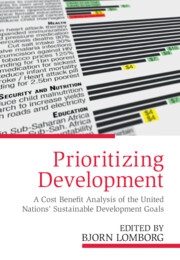 Prioritizing Development
Prioritizing Development Published online by Cambridge University Press: 30 May 2018
Introduction
In its deliberations regarding development of the Sustainable Development Goals (SDGs), the United Nations (UN) working group considered various issues involving science and technology (S&T) initiatives. In general, the working group viewed technology development and transfer as a way to “strengthen and enhance means of implementation and global partnership for sustainable development.” The inclusion of S&T to help achieve SDG is sensible because access to, and effective implementation of, knowledge and technical information are fundamentally important sources of economic growth (Keller, 2004). They are equally central in meeting public needs, such as adaptation to climate change, water safety, and public health (Maskus and Okediji, 2014). Thus, S&T initiatives speak both to economic development and sustainability, making them a suitable candidate for inclusion in the SDG in some form.
Unfortunately, most of the cases in which technology was listed in the UN working documents involved broad aspirations, rather than clearly articulated targets. This lack of policy specificity is unsurprising because technology transfer and investments in research and development (R&D) are largely private decisions, although significant expenditures are also undertaken by public authorities and their grantees. In this context, such words as promote and encourage are appropriate in this area because the primary objectives may simply be to improve market and governance conditions to induce firms to disseminate technologies and undertake R&D programs that are conducive to economic and social development. Such exhortations are difficult to assess numerically, however.
Because of this limited information, this chapter articulates specific objectives that both facilitate the broad objectives of the SDG and are amenable to reasonable cost-benefit calculations. I select two cross-cutting objectives that, if achieved, could offer strong facilitation to technology diffusion, access to knowledge, and growth of technological capacities in developing countries.
To save this book to your Kindle, first ensure [email protected] is added to your Approved Personal Document E-mail List under your Personal Document Settings on the Manage Your Content and Devices page of your Amazon account. Then enter the ‘name’ part of your Kindle email address below. Find out more about saving to your Kindle.
Note you can select to save to either the @free.kindle.com or @kindle.com variations. ‘@free.kindle.com’ emails are free but can only be saved to your device when it is connected to wi-fi. ‘@kindle.com’ emails can be delivered even when you are not connected to wi-fi, but note that service fees apply.
Find out more about the Kindle Personal Document Service.
To save content items to your account, please confirm that you agree to abide by our usage policies. If this is the first time you use this feature, you will be asked to authorise Cambridge Core to connect with your account. Find out more about saving content to Dropbox.
To save content items to your account, please confirm that you agree to abide by our usage policies. If this is the first time you use this feature, you will be asked to authorise Cambridge Core to connect with your account. Find out more about saving content to Google Drive.